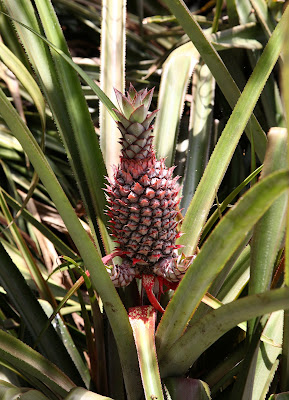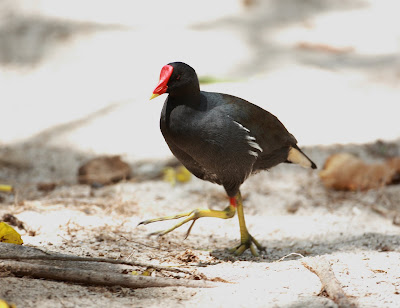It was not easy to get to Aride. Creole Travel Services arrange trips to Aride but the minimum group is eight people. Birds don't seem to attract tourists in the same way as giant tortoises do. At last a trip was arranged. It was some more expensive than a regular trip, but definitely worth it. Everything was luxury - own boat, skipper, two guides, lunch on the beach and birds that you probably will not see again. Many thanks to the guides and the skipper.

Beach was so shallow that a rubber boat was used to go ashore.

Brown Noddies and

Lesser Noddies were at the sea level.
Seychelles Magpie-robins were absolutely tame.


Magpie-robin was right on the spot if you swept some leaves aside.

Modern apparatus to slake your thirst.

Fairy Terns take a break.

Seychelles Fody has not always been common in Aride, because only two birds were recorded on Aride during 1988 - 1995 (BoS).
It seems apparent that the green fruit meets a sticky end, however, BoS says that the Seychelles Fody is mainly insectivorous. Strangely enough, it has a seed eater's bill.

The BoS says that only female Seychelles Warblers incubate; helpers may share this duty, giving almost continuous protection from predators such as skinks and Seychelles Fody, which more than doubles hatching success. Helpers share almost all aspects of nesting, rearing and defending young. Helpers are of close kin, inluding helpers to step-parents.

Remarkably, Warblers' sex ratio is known to depend strongly on the environment. In territories where food is scarce, nearly 80% of eggs will produce males (which will leave the territory as soon as possible), whereas where food is plentiful, nearly 90% will be females (which may be recruited as helpers).
After that the Warblers were left alone and there was a steep climb to the clifftop.

A pineapple in the halfway.

A dead millipede at the same spot
Then a welcome bird was in a tree.

Seychelles Blue Pigeon became extinct on Aride, but has re-invaded by natutal means; first recorded October 1990 when five birds were noted and has subsequently bred in small numbers (Bos).
BoS says that the Blue Pigeon is fairly common in wooded granitic islands, but Aride is the only place I ever see Blue Pigeons (total 4). In 1980, it was rarely seen below 200 m, but it should now occur to the sea level.


The bird is only 23-25 cm long, but it seems bigger due to its sturdy appearance.

Diet mainly seeds and fruits, inluding those of takamaka, vouloutye, cinnamon and guava.
Shearwaters can normally be seen well out to sea.

Audubon's Shearwater nests on rat- and cat-free islands and islets of coral atolls. There is no clear breeding season in the granitic islands, incubating birds being found in any month. The single white egg is laid in the rock crevice or, where there is deeper soil, at the end of a long burrow (BoS).

Wedge-tailed Shearwater may breed also in any month, but there is general pattern of prospecting for burrows in August, laying in September, with chicks from December to January (BoS).

White-tailed Tropicbirds
The clifftop was worth clambering!

Sooty Tern on a shelf of a rock

and in the air.

Lesser and Great Frigatebirds.

Great Frigatebird's wingspan is 205-230 cm.


The clifftop was a place in which you could stay forever, in particular due to Red-tailed Tropicbirds.

The length is 78-81 cm (tail 30-35 cm); wingspan 104-119 cm (BoS).


At the end we had to descend back to the sea level. It was time for the lunch.

Madagascar Turtle Dove and Seychelles Fody attended a lunch too.

Moorhens are pretty shy in Finland but they are not shy in Aride. When we were finishing our lunch Fody and Dove landed on the barbecue in the hope of some food. Then Moorhen strode on the spot, jumped on the barbecue, kick Fody and Dove away and took what it needed.
After lunch I got badly humiliated. The Fody really put me in my place.
Hannu: It's on the bottom of by backpack so I can't reach it easily. You seem to have a decent mobile on the table.
Fody: Aren't you ashamed of your eight years old model?
Hannu: How do you know that I'm armed with that one?
Fody: Everybody knows that. You keep charging it all along, you hide it until dark and it interferes our modern equipment. I wonder how you managed to get it through the customs in the first place. We generally don't want to see that kind of rubbish in the islands.
.
.
This was a birder's view of Aride. The last text is primarily about the waders in Praslin, but also some crabs, bats and land birds.
.
.
Hannu Rinne






Ei kommentteja:
Lähetä kommentti